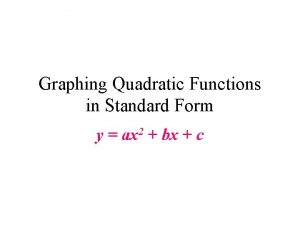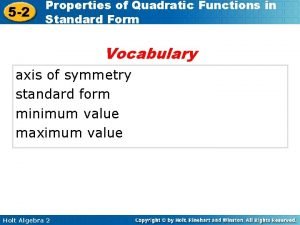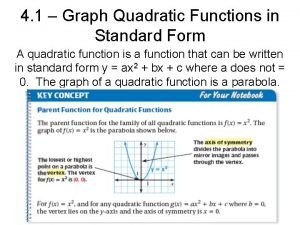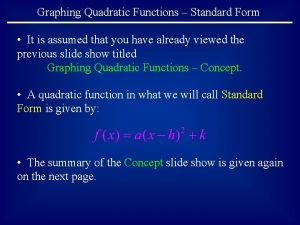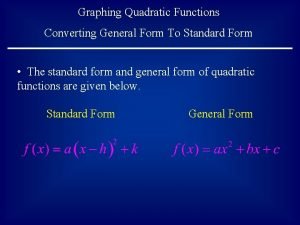Graphing Quadratic Functions in Standard Form y ax










- Slides: 10

Graphing Quadratic Functions in Standard Form y = ax 2 + bx + c

Quadratic Functions y The graph of a quadratic function is a parabola. Vertex (Maximum) A parabola can open up or down. If the parabola opens up, the lowest point (minimum) is called the vertex. x If the parabola opens down, the vertex is the highest point (maximum). NOTE: if the parabola opened left or right it would not be a function! Vertex (Minimum)

Standard Form y The standard form of a quadratic function is a>0 y = ax 2 + bx + c The parabola will open up when the a value is positive. x The parabola will open down when the a value is negative. a<0

Line of Symmetry Parabolas have a symmetric property to them. Lineyof Symmetry If we drew a line down the middle of the parabola, we could fold the parabola in half. We call this line the line of symmetry. x The line of symmetry ALWAYS passes through the vertex.

Finding the Line of Symmetry When a quadratic function is in standard form y = ax 2 + bx + c, The equation of the line of symmetry is This is best read as … the opposite of b divided by the quantity of 2 times a. For example… Find the line of symmetry of y = 3 x 2 – 18 x + 7

Finding the Vertex We know the line of symmetry always goes through the vertex. Thus, the line of symmetry gives us the x – coordinate of the vertex. To find the y – coordinate of the vertex, we need to plug the x – value into the original equation. For example, Find the vertex y = – 2 x 2 + 8 x – 3

A Quadratic Function in Standard Form The standard form of a quadratic function is given by y = ax 2 + bx + c STEP 1: Find the line of symmetry STEP 2: Find the vertex STEP 3: Make a table of values using x values close to the line of symmetry. (Put the vertex in the middle of your table of values. )

A Quadratic Function in Standard Form Example 1 y a. Graph b. Find and label the axis of symmetry. c. Find the maximum/minimum d. Find the domain & range y = 2 x 2 – 4 x – 1 x

A Quadratic Function in Standard Form Example 2 a. Graph b. Find and label the axis of symmetry. c. Find the maximum/minimum d. Find the domain & range y = x 2 - 2 x – 1 y x

A Quadratic Function in Standard Form Example 3 a. Graph b. Find and label the axis of symmetry. c. Find the maximum/minimum d. Find the domain & range y = -1/6 x 2 – x – 3 y x
 Standard form y=ax^2+bx+c
Standard form y=ax^2+bx+c Vertex form of a quadratic function
Vertex form of a quadratic function Standard form properties
Standard form properties Properties of quadratic functions
Properties of quadratic functions The standard form of a quadratic equation is
The standard form of a quadratic equation is How to graph a function in standard form
How to graph a function in standard form Properties of quadratic functions in standard form
Properties of quadratic functions in standard form Properties of quadratic function
Properties of quadratic function How to graph quadratic functions in standard form
How to graph quadratic functions in standard form How to find a in vertex form
How to find a in vertex form Suppose a particular star is projected from a firework
Suppose a particular star is projected from a firework
